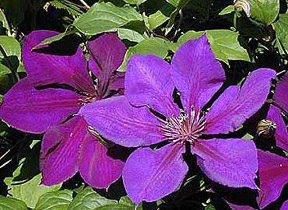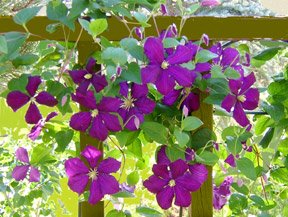 Mother Nature is sorely testing our limits. Day after day, temperatures rise to the triple digits. Like a furnace blast, hot winds batter my poor garden. Geraniums hang their heads. Columbines are screaming for mercy. Tiny Lobelia has run out of steam.
Mother Nature is sorely testing our limits. Day after day, temperatures rise to the triple digits. Like a furnace blast, hot winds batter my poor garden. Geraniums hang their heads. Columbines are screaming for mercy. Tiny Lobelia has run out of steam.For a few weeks, each summer, this place feels like Hell's Kitchen. But, that's when bright red, and rosy pink, Jupiter's Beard* steals the show. Clusters of feisty flowers wave their pretty heads back and forth, in defiance of scorching temperatures and strong winds.
 You can avoid a lot of heartache if you know what grows. I'm no expert, but I've learned a trick or two. Jupiter's Beard (or Valerian) is the loveliest, most adaptable, perennial I've ever met. It's a mystery to me why so few people have it in their gardens.
You can avoid a lot of heartache if you know what grows. I'm no expert, but I've learned a trick or two. Jupiter's Beard (or Valerian) is the loveliest, most adaptable, perennial I've ever met. It's a mystery to me why so few people have it in their gardens.But then... the whole plant is a mystery. Most folks latch onto the title 'Valerian' and confuse it with the medicinal herb, claiming it cures afflictions, from depression to delusions. In truth, the only way this plant 'cures' depression is when you soak in its breathtaking show.
 During the dog days of summer, we need plants that don't slouch. Place Jupiter's Beard in with these other heat-loving perennials: Yellow/Coreopsis, Purple/Salvia, Blue/Cat Mint. They'll stand up to anything Mother Nature dishes out.
During the dog days of summer, we need plants that don't slouch. Place Jupiter's Beard in with these other heat-loving perennials: Yellow/Coreopsis, Purple/Salvia, Blue/Cat Mint. They'll stand up to anything Mother Nature dishes out.* Valerianaceae Centranthus ruber (Jupiter's Beard or Valerian) USDA zone 5 - 8, is an easy grower by seed. As is Coreopsis, Salvia and Cat Mint. Buy quality seeds or seedlings from Backyard Gardener and other online shops.


















